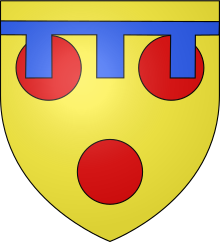Francis Courtenay, de jure 4th Earl of Devon, (c. 1576 – 3 June 1638) of Powderham, Devon, was an English Member of Parliament.[2] In 1831 he was recognised retrospectively as having been de jure 4th Earl of Devon, having succeeded his father in 1630.
Francis Courtenay | |
|---|---|
 | |
| Born | c. 1576 |
| Died | 3 June 1638 (aged 61–62) |
| Resting place | St Clement's Church, Powderham, Devon 50°39′01″N 3°27′17″W / 50.6503°N 3.4547°W |
| Nationality | English |
| Occupation | MP |
| Spouses |
|
| Children | Sir William Courtenay, 1st Baronet Edward Courtenay Francis Courtenay James Courtenay Elizabeth Courtenay |
| Parent(s) | Sir William Courtenay Elizabeth Manners |
Origins edit
Courtenay was the second but eldest surviving son of Sir William Courtenay (1553–1630), de jure 3rd Earl of Devon of Powderham Castle, Devon, by his first wife Elizabeth, daughter of Henry Manners, 2nd Earl of Rutland (1526–1563).[3]
Career edit
He was MP for Devonshire in 1625[2] and possibly for Grampound in 1626.[4] In 1633 he was Colonel of a regiment of the Devon Trained Bands.[5]
Marriages and issue edit
Courtenay married twice. He married firstly, 7 November 1606, Mary (born 1586), widow of Nicholas Hurst of Oxton, Devon and eldest daughter of Sir William Pole (1561–1635), of Colcomb, Devon.[6] They had no children.
He married secondly, by 1628,[2] Elizabeth, daughter of Sir Edward Seymour, 2nd Baronet (c. 1580 – 1659) of Berry Pomeroy, Devon, by whom he had issue:[7]
- Sir William Courtenay, 1st Baronet (died 1702), married Margaret, daughter of Sir William Waller.
- Edward Courtenay, baptised on 17 July 1631 at Powderham.
- Francis Courtenay, baptised on 14 July 1633, married, 11 January 1658, Rebecca, daughter of Major John Webb of Exeter.
- James Courtenay, baptised on 18 January 1635 at Powderham.
- Elizabeth Courtenay
Death edit
Courtenay died on 3 June and was buried on 5 June 1638 at Powderham, Devon.[3][7] He was succeeded by his eldest son, William. His widow later married Sir Amos Meredith, 1st Baronet of Marston, Devon. She died by 6 February 1664.[3]
Notes edit
- ^ These were also the arms of Hugh Courtenay, 2nd Earl of Devon (died 1377), and can be seen impaling Bohun on the monumental brass of one of his younger sons, Sir Peter Courtenay (died 1405), in Exeter Cathedral
- ^ a b c Venning & Hunneyball 2010.
- ^ a b c Mosley 1 2003, p. 1124.
- ^ Venning & Hunneyball 2010: "The Francis Courtney elected in 1626 at Grampound was most likely a Cornish namesake, although Courtenay’s distant kinship with one of the borough’s patrons, John Mohun, means that he cannot be entirely ruled out."
- ^ Devon Trained Bands 1633 at the British Civil War Project (archived at the Wayback Machine).
- ^ Vivian 1895, p. 247, 603.
- ^ a b Vivian 1895, p. 247.
References edit
- Hasler, P.W. (1981). "Courtenay, Sir William I (1553-1630), of Powderham, Devon". In Hasler, P.W. (ed.). Members. The History of Parliament: The House of Commons 1558–1603. Historyofparliamentonline.org. Retrieved 7 December 2013.
- Mosley, Charles, ed. (2003). Burke's Peerage, Baronetage and Knightage. Vol. 1 (107th ed.). Wilmington: Burke's Peerage & Gentry LLC. ISBN 0971196621.
- Venning, Tim; Hunneyball, Paul (2010). "Courtenay, Francis (c.1576-1638), of Powderham, Devon". In Thrush, Andrew; Ferris, John P. (eds.). The History of Parliament: the House of Commons 1604-1629. historyofparliamentonline.org.
- Vivian, J.L. (1895). The Visitations of the County of Devon, Comprising the Heralds' Visitations of 1531, 1564, to 1620, with additions by J.L. Vivian. Exeter: H.S. Eland.
External links edit
- Venning, Tim; Hunneyball, Paul (2010). "Courtenay, Francis (c.1576-1638), of Powderham, Devon". In Thrush, Andrew; Ferris, John P. (eds.). The History of Parliament: the House of Commons 1604-1629. at historyofparliamentonline.org
- Devon, Earl of (E, 1553) at cracroftspeerage.co.uk